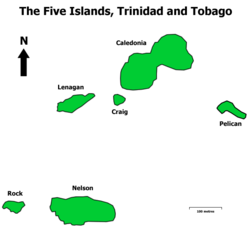
Rock Island (Trinidad and Tobago)
Encyclopedia

Trinidad and Tobago
Trinidad and Tobago officially the Republic of Trinidad and Tobago is an archipelagic state in the southern Caribbean, lying just off the coast of northeastern Venezuela and south of Grenada in the Lesser Antilles...
, part of the Five Islands group of islands. It is located in the Gulf of Paria
Gulf of Paria
The Gulf of Paria is a shallow inland sea between the island of Trinidad and the east coast of Venezuela. This sheltered body of water is considered to be one of the best natural harbours on the Atlantic coast of the Americas...
, approximately 2 kilometres off the main island of Trinidad
Trinidad
Trinidad is the larger and more populous of the two major islands and numerous landforms which make up the island nation of Trinidad and Tobago. It is the southernmost island in the Caribbean and lies just off the northeastern coast of Venezuela. With an area of it is also the fifth largest in...
from Point Gourde. Of the "Five Islands", which are actually made up of six different islands , Rock is the second smallest (after Craig Island
Craig Island
Craig Island is an island in the Republic of Trinidad and Tobago. It is one of “The Five Islands” group of six small islands lying west of Port of Spain in the Gulf of Paria. Craig Island is joined to Caledonia Island by a small causeway.-See also:...
) and the most western of the group.
Characteristics
Rock was named after its physical characteristics , due its small size and sparse vegetation. The island is very small, no more than 50 metres in length and 30 metres in breadth at its widest point. The island, as with the other Five Islands, is made up primarily of limestoneLimestone
Limestone is a sedimentary rock composed largely of the minerals calcite and aragonite, which are different crystal forms of calcium carbonate . Many limestones are composed from skeletal fragments of marine organisms such as coral or foraminifera....
, as the islands were geologically formed by a raised coral reef
Coral reef
Coral reefs are underwater structures made from calcium carbonate secreted by corals. Coral reefs are colonies of tiny living animals found in marine waters that contain few nutrients. Most coral reefs are built from stony corals, which in turn consist of polyps that cluster in groups. The polyps...
. Today the island is uninhabited, with remnants of its last use as a quarantine
Quarantine
Quarantine is compulsory isolation, typically to contain the spread of something considered dangerous, often but not always disease. The word comes from the Italian quarantena, meaning forty-day period....
depot being reclaimed by trees.
History

Spanish Empire
The Spanish Empire comprised territories and colonies administered directly by Spain in Europe, in America, Africa, Asia and Oceania. It originated during the Age of Exploration and was therefore one of the first global empires. At the time of Habsburgs, Spain reached the peak of its world power....
up until 1818, the island was not believed to be inhabited. Its first documented usage was its leasing to wealthy private citizens by the Government in the early 19th century for use as a holiday home. It was first leased to T.F. Johnston who subsequently sold it to Doctor R. Mercer. Dr. Mercer then gave the lease as a present to Master Thomas Laughlin . During these times, a house was built on the island and rented out to the public . By 1888, the island was being used as a quarantine depot for first-class passengers of ships that may have highly contagious diseases. A flagpole was placed on the island, which when raised with a yellow flag warned that the inhabitant(s) had a certifiable contagious disease, which barred public communication with the island .

